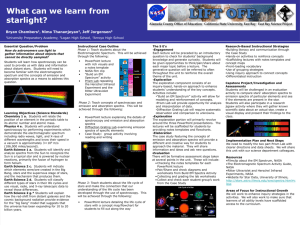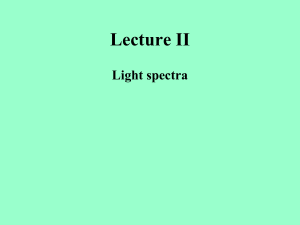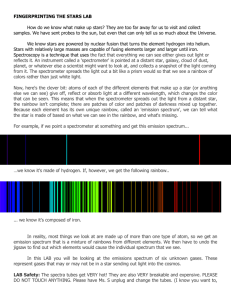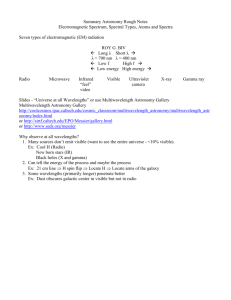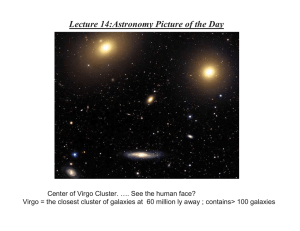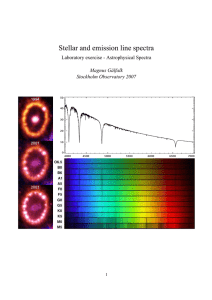PPT
advertisement
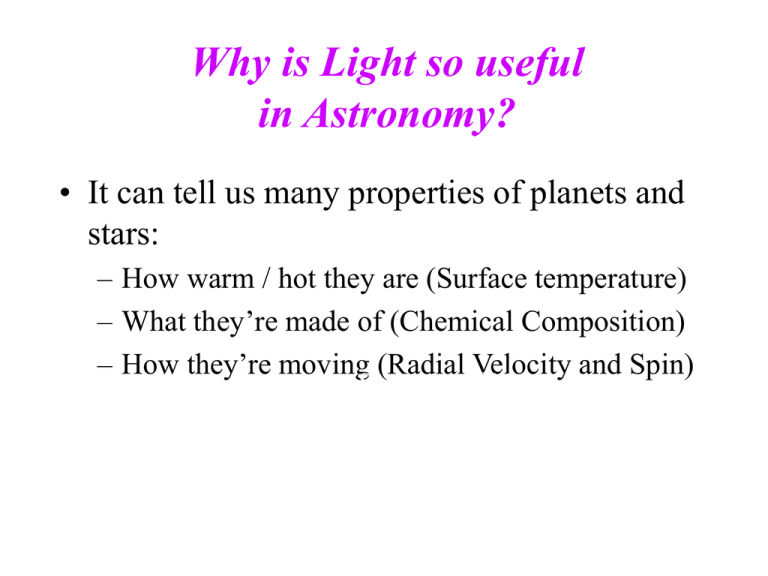
Why is Light so useful in Astronomy? • It can tell us many properties of planets and stars: – How warm / hot they are (Surface temperature) – What they’re made of (Chemical Composition) – How they’re moving (Radial Velocity and Spin) Spectrum of Mars Interaction of Light and Matter: Four Ways 1. 2. 3. 4. emission – matter releases energy (E) as light absorption – matter takes E from light transmission – matter allows light to pass reflection – matter repels light in another direction CONSERVATION OF ENERGY Emission - Continuous • Hot, dense objects give off continuous thermal blackbody radiation – Warm objects emit infrared – Hotter • More light • Shorter wavelengths • e.g. Stars emit visible light! • IR Spectrum We can measure planet’s surface temperature! Reflection: Application • When light passes through matter, or reflects off of matter, some wavelengths may be absorbed • Resulting spectrum tells us about the matter! – Example: Mars appears red because it’s surface absorbs more blue light than red (reflects more red light than blue) tells us something about what surface is made of Blackbody Activity 5 Application to Stars: Thermal Radiation • Bluer Stars are hotter than redder ones! 6 Emission & Absorption • Photons can be absorbed / emitted by matter: – Photon energy matches “jump” in energy levels • http://www.astro.uiuc.edu/projects/data/S pectra/orbitals.html • Atoms absorb photon & gain energy Absorption-line spectrum • Atoms emit photon & lose energy Emission-line spectrum Kirchhoff’s Laws: Kinds of Spectra Types of Spectra Activity 9 Element Identification Only • •Fig. 6.8photons whose energies (colors) match the “jump” in Hydrogen electron energy levels can be emitted or absorbed. • Each element has a unique signature because of its energy level structure 10 Application : Chemical Composition • Presence of absorption lines of a particular element indicates the presence of that element in the absorbing material – e.g. atmosphere of a star! Artificial (Absorption-line) Solar Spectrum: Laboratory (Emission-line) Spectrum of Iron: 11 Application to Stars: Absorption spectra • Outer layers of a star are cooler than the dense inner part (i.e. they are the “cool cloud”) Application: Emission Spectra • Tails of Comets consist of dust which reflects sunlight, and excited gas which produces an emission-line spectrum. From http://www.astron.pref.gunma.jp/gallery/comet_2001Q4.html Application : Chemical Composition • Presence of emission lines of a particular element indicates the presence of that element in the excited gas From: http://www.pbs.org/wgbh/nova/origins/spectra.html The Doppler Effect How is light affected by the velocity of a source? (Alternate views: http://www.fearofphysics.com/Sound/dopwhy2.html and http://lectureonline.cl.msu.edu/~mmp/applist/doppler/d.htm) The Doppler Effect Motion toward observer shortens wavelength (Blue Shift) Motion away from observer lengthens it (Red Shift) Faster speed bigger change in Measuring Radial Velocity • Measure Doppler shift of emission or absorption lines in a spectrum radial velocity of object • No Motion • Motion away • Motion towards From: http://www.psi.edu/esp/method.html Doppler Effect Activity 18 Measuring Radial Velocity From: http://woodahl.physics.iupui.edu/05-22_anno.jpg 19 Application: Orbiting Stars • Motions of stars moving towards & away from us • Mizar: – Really 4 stars! – Binary Stars – Extrasolar planets (http://ircamera.as.arizona.edu/NatSci102/NatSci102/lectures/spectroscopy.htm) More Applications • Spin of Venus and/or asteroids: – Radar measurements • Expansion of Universe: – Distant galaxies moving away from us Why is Light so Useful? • Thermal / continuous spectrum temperature • Reflected light properties of reflecting object • Absorption features composition of absorbing material (e.g. star, planet atmosphere) • Emission lines composition of thin gas (e.g. nebula, tail of comet) • Doppler effect on lines radial velocity, spin!

